If you’re looking for help to identify black and red birds, this will be the best article you read today.
In this post, you will find photos, identification info, bird songs, calls, and all the fun information you need.
Examples of black and red birds include the red-breasted meadowlark, red-necked woodpecker, red siskin, northern cardinal, great frigatebird, scarlet tanager, and many others.
Here are the 25 most interesting ones.
Table of Contents
Black And Red Birds
Red-breasted Meadowlark

- Scientific name: Sturnella militaris
- Lifespan: n/a
- Wingspan: n/a
Red-breasted meadowlarks are small songbirds native to Costa Rica.
They inhabit the open country, moist grasslands, pastures, and cultivation areas, especially if there is a bush or fence post for males to perch.
Male red-breasted meadowlarks are black with crimson red throats, breasts, upper bellies, and shoulders. Females are brown mottled and streaked.
To identify red-breasted meadowlarks in nature, you should listen for several metallic chips followed by a dissonant buzz.
As part of their courtship ritual, males will sing a wheezing song that sounds like “ti-ti-pee-pee-KWAAAAAA“.
Source: Niels Krabbe, CC BY-SA 4.0, via Wikimedia Commons
These black and red birds are gregarious and forage on the ground; their diet mainly consists of insects and seeds.
They can be found in flocks of up to 100 individuals, occasionally even more.
White-browed Meadowlark

- Scientific name: Leistes superciliaris
- Lifespan: n/a
- Wingspan: n/a
Once named white-browed blackbirds, the white-browed meadowlarks are medium-sized songbirds native to South America.
They breed in Brazil and southern parts of South America and can be seen in open country, around wet grasslands and in agricultural areas.
Male white-breasted meadowlarks are mainly black with bright red throats, bellies, epaulets (shoulder patches), and white eyebrows. Females are mostly brown and streaky.
Their song consists of a series of notes that sound like “tzz-tee-chu-chu-chak” while the call is a short “chuck“.
White-browed meadowlarks are very social and often forage on the ground. They are omnivores that consume insects and seeds.
They look like red-breasted meadowlarks with the main difference being the white eyebrows absent in red-breasted ones.
Pileated Woodpecker

- Scientific name: Dryocopus pileatus
- Lifespan: 12 years
- Wingspan: 26-30 in
Pileated woodpeckers are one of the largest woodpeckers native to North America.
They breed in the forests of Canada, Eastern USA, and on the Pacific coast.
The word “pileated” comes from the Latin word “pileatus” which means “capped”.
Pileated woodpeckers are primarily black with a prominent red crest on their heads. They also have white lines on their throats and white on their wings.
Males also have red lines on the side of their heads; this is absent in females.
Look for them hitting dead trees in pursuit of ants and making rectangular holes in the process.
These black and red woodpeckers are omnivores that feed on insects (especially carpenter ants), fruits, nuts, and berries.
They are rare around bird feeders; the only way they visit them is if the winter is extremely cold.
Try to attract pileated woodpeckers to your backyard by adding suet to your feeders, leaving dead trees for them to forage or roost there, or putting up a nest box to attract a breeding pair.
Pileated woodpeckers are crucial for making tree holes that other bird and animal species use to nest.
The famous cartoon character, Woody Woodpecker, is said to have been based on pileated woodpeckers.
Great Frigatebird
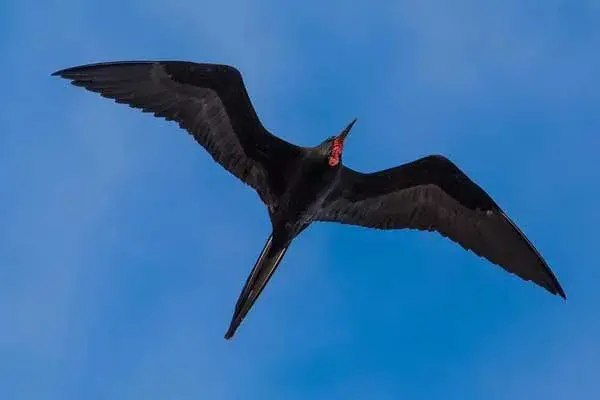
- Scientific name: Fregata minor
- Lifespan: up to 40 years
- Wingspan: 81-91 in
Great frigatebirds are huge seabirds that can grow up to 3.4 ft long, span 7 ft 7 in across the wings, and weigh as much as 3.5 lbs.
They can be found in the tropical Pacific and Indian Oceans, and in the South Atlantic Ocean.
Females tend to be bigger than males.
Male great frigatebirds are completely black and have striking red gular sacs they inflate to attract females. Females have white throats.
As part of the courtship ritual, great frigatebirds will also clatter their beaks, wave heads and wings, and males will call to females while flying overhead.
They have the highest ratio of wing area to body mass and the lowest wing loading of any bird – scientists speculate that this helps them soar at great heights and preserve energy.
Great frigatebirds are seasonally monogamous and stay together for a season.
They are rather cheeky and will often steal fish and other food from other seabirds.
They will chase and harass birds, make them regurgitate their food, and then swoop in and catch the food in the air.
Magnificent Frigatebird

- Scientific name: Fregata magnificens
- Lifespan: 14-30 years
- Wingspan: 85-96 in
With a length of almost 4 feet and a wingspan of up to 8 feet, magnificent frigatebirds are the largest species of frigatebird in the world.
In North America, they are most commonly found in the Gulf of Mexico, around states like Texas and Florida.
Named magnificent due to their striking appearance and behavior, these large red and black birds are easy to recognize due to their huge size, long pointed wings, and long deeply forked tails.
Male magnificent frigatebirds are all-black and have scarlet throat pouches they inflate like balloons during the breeding season. Females are also black but have white breasts and lower neck sides.
They mostly feed on fish taken in flight from the ocean’s surface and their favorite food is flying fish, tuna, and squid.
Just like the great frigatebirds, magnificent frigatebirds will also harass and steal fish from other animals. This is known as kleptoparasitism.
Despite their massive wingspans, these birds can’t land on water as their feathers aren’t waterproof and they would most likely drown.
Red-necked Woodpecker
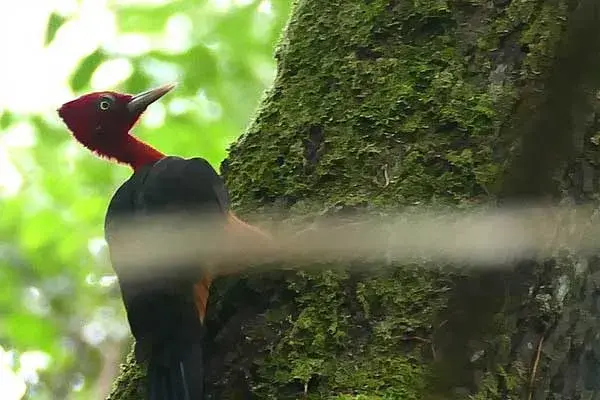
- Scientific name: Campephilus rubricollis
- Lifespan: n/a
- Wingspan: n/a
Red-necked woodpeckers are large woodpeckers primarily found in subtropical or tropical moist lowland and moist montane forests of South America.
They are common in countries like Bolivia, Brazil, Colombia, Peru, Venezuela, Ecuador, and Guyana.
Red-necked woodpeckers have black wings, black backs, and deep red necks, heads, and underparts. Their beaks are pale grayish-white.
They are often found in pairs and family groups, at large dead trunks within the forest.
Red-necked woodpeckers are omnivores that feed on trees, consuming larvae of large beetles and moths, and some fruit.
Bare-necked Umbrellabird
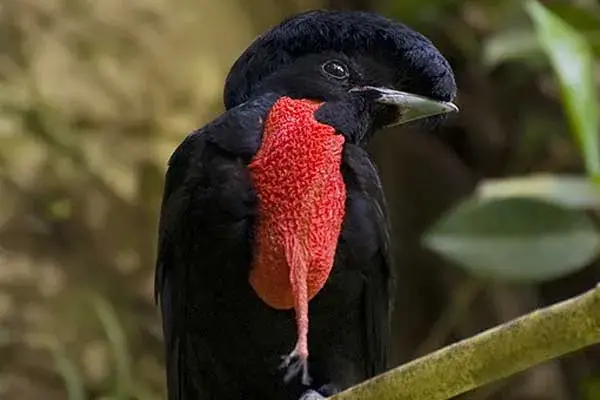
- Scientific name: Cephalopterus glabricollis
- Lifespan: 12-20 years
- Wingspan: n/a
Bare-necked umbrellabirds are large black and red birds native to the forests of Costa Rica and Panama.
They are listed as endangered by the International Union for Conservation of Nature (IUCN) and scientists estimate a global population of under 2,500 birds.
In person, these birds are unmistakable. Both sexes are with large stocky bodies, hefty beaks, short tails, and wide, long wings.
Male bare-necked umbrellabirds are black with stunning Mohican-like black crests on their heads and scarlet-colored bare necks and throats.
Females are smaller than males and have smaller crests with no bare skin on the throat. They also resemble purple-throated fruitcrows a bit.
Bare-necked umbrellabirds are omnivorous and feed on fruits, berries, and some lizards, frogs, insects, and larvae.
Scarlet-rumped Tanager
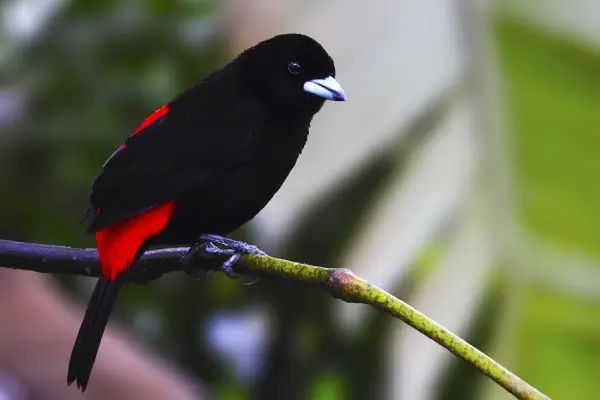
- Scientific name: Ramphocelus passerinii
- Lifespan: n/a
- Wingspan: n/a
Scarlet-rumped tanagers are medium-sized songbirds found in Mexico and Central America, around semi-open areas, woodland edges, gardens, and pastures.
They measure around 6.3 inches long and weigh around 1.1 oz.
Male scarlet-rumped tanagers are black with scarlet red rumps. Females have olive upperparts and brownish underparts.
Identify them by their song consisting of several clear pleasant notes and their sharp “wac” call.
Source: Oliver Komar, CC BY-SA 4.0, via Wikimedia Commons
Scarlet-rumped tanagers can be seen in pairs or small groups, occasionally with other species.
They are omnivores and feed on insects, spiders, and some small fruit.
Scarlet-rumped tanagers nest high in trees and have a clutch of 2 pale bluish-gray eggs with brown spots.
Pesquet’s Parrot

- Scientific name: Psittrichas fulgidus
- Lifespan: 20-40 years
- Wingspan: n/a
Pesquet’s parrots are large red and black parrots native to the rainforests of New Guinea.
They measure around 18 inches in length and weigh 24-28 ounces.
Pesquet’s parrots have black plumage with bright red bellies, rumps, and wing feathers.
They also have bare black faces and long and hooked beaks giving them the nickname “vulturine parrots, ” one of their many.
Pesquet’s parrots are also known as Dracula’s parrots but do not follow Dracula’s diet.
Instead, they are frugivores that mainly feed on several species of figs, some flowers, and nectar.
Pesquet’s parrots are usually seen in pairs or small groups of up to 20 birds.
Their stunning plumage makes them very prized among bird watchers; this in combination with habitat loss has placed them on the list of Vulnerable species.
They have very harsh and rasping calls that people describe as “growling”.
Red-winged Blackbird
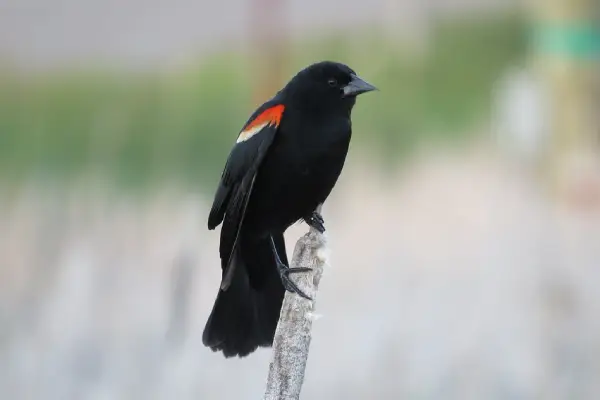
- Scientific name: Agelaius phoeniceus
- Lifespan: 2 years in the wild
- Wingspan: 12-16 in
Red-winged blackbirds are small songbirds found in North and Central America.
They can weigh as little as 1.46 oz and measure 6.7 inches in length, making them one of the smallest black birds in the world.
Their scientific name “agelaios” means “gregarious,” while the “phoeniceus” means “crimson” or “red,” which perfectly describes them.
Male red-winged blackbirds are completely black with red epaulets edged in yellow.
They often make red-shoulder displays and emit rich and scratchy “oak-a-lee” songs.
Females are smaller, streaky brown above, and paler below.
They have a scolding chatter that sounds like “chit-chit-cheer-teer-teer.”
Source: G. McGrane, Public domain, via Wikimedia Commons
Red-winged blackbirds are one of North America’s most abundant and gregarious birds – scientists often discover flocks that can have over a million birds!
They are also very territorial and polygynous and a single male can have up to 10 different females making nests in his territory.
Females, on the other hand, will frequently mate with other males, and often lay eggs of mixed paternity. They will have a clutch of 3-4 pale blue-green eggs with dark streaks.
Red-winged blackbirds are omnivores and feed on insects, seeds, and grain.
Purple-throated Fruitcrow
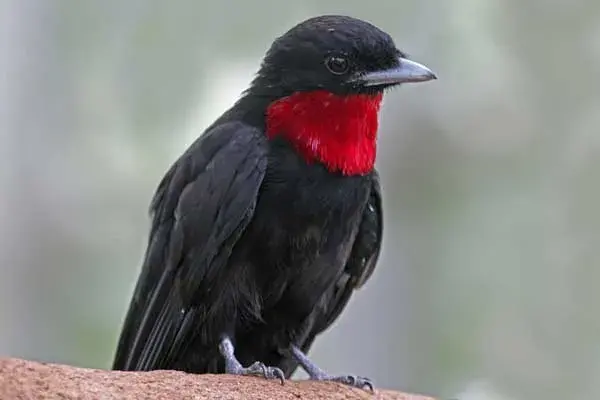
- Scientific name: Querula purpurata
- Lifespan: n/a
- Wingspan: n/a
Purple-throated fruitcrows are large black birds native to the humid lowland forests of Central and South America.
There, they feed mainly on insects and fruit.
Identify them by their short wide pointed grayish bills, black eyes, gray legs, and strong sounds.
These vocal birds will make low, mellow whistles, such as “oo-waa”, “wooo,” and “wheeoowoo” to communicate.
Source: Niels Krabbe, CC BY-SA 4.0, via Wikimedia Commons
Purple-throated fruitcrows are glossy black with wine-red throats, similar to gorgets hummingbirds have.
Their red-colored neck plumage can be puffed out expressively.
Purple-throated fruitcrows are often found around other larger birds (falcons, caciques, and oropendolas) and will always travel in groups of 3-6 individuals.
To seduce females, males will flare out their brilliant throat feathers, shake their tails back and forth, and make piercing calls.
Despite their name, purple-throated fruitcrows consume both fruits and insects; this makes them an omnivorous species.
Southern Ground Hornbill

- Scientific name: Bucorvus leadbeateri
- Lifespan: 40-50 years
- Wingspan: 47-70.8 in
The southern ground hornbill is the largest hornbill species in the world.
Identify them by their distinctively large, down-curved beaks they use to catch small animals found in the grasses and shrubs.
Adult southern ground hornbill males are completely black with vivid red patches of bare skin on their faces and throats; females have bluish throats.
They are commonly found in Southern Africa and inhabit both woodlands and savannas.
As the name suggests, southern ground hornbills will stay most of their time on the ground.
They can fly but some studies discovered that they spend around 70% of their day walking.
Southern ground hornbills are apex predators that hunt reptiles, frogs, snails, insects, and hare-sized mammals.
In the early morning, the song of these red-necked birds can be heard from miles away, with pairs singing in a duet with a deep-bass booming “oooh-oooh-ooh-oh” sounds.
Southern ground hornbills are long-lived species that can live up to 70 years in captivity!
Read More: More examples of beautiful birds with red necks
Scarlet-throated Tanager

- Scientific name: Compsothraupis loricata
- Lifespan: n/a
- Wingspan: n/a
Scarlet-throated tanagers are small songbirds endemic to eastern Brazil.
They inhabit areas with water, at elevations ranging from 660 ft to 3280 ft.
Male scarlet-throated tanagers are glossy black with bright red throats that are absent in females.
They are one of the largest species of tanagers that can be typically seen in pairs or groups of up to 8 individuals. Scarlet-throated tanagers will often perch on branches high in trees.
Conspicuous and rather slow-moving, they mostly feed on insects.
Scarlet-throated tanagers like to hide their nests, usually deep in vegetation or abandoned woodpecker’s holes.
Zanzibar Red Bishop

- Scientific name: Euplectes nigroventris
- Lifespan: n/a
- Wingspan: n/a
Zanzibar red bishops are small and short-tailed songbirds found in Africa.
They breed in Kenya, Mozambique, and Tanzania, around marshes, flooded grasslands, and cultivated areas.
Breeding male Zanzibar red bishops are black below and orange-red above.
Females and non-breeding males are brownish with streaks.
Identify them by their song which is long and rattling; the most common call is a rough “tek“.
Their diet mainly consists of seeds.
Southern Red Bishop
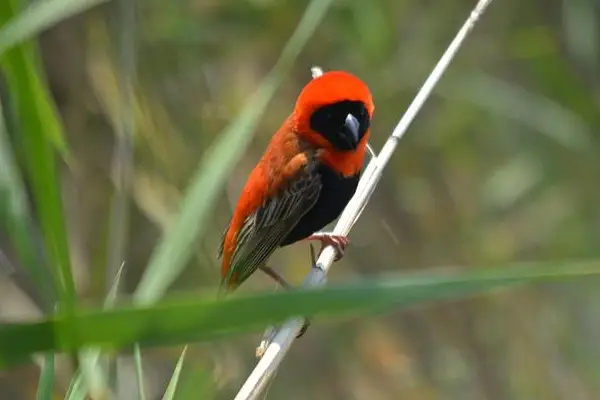
- Scientific name: Euplectes orix
- Lifespan: over 12 years
- Wingspan: n/a
Southern red bishops are small songbirds found in wetlands and grasslands of Africa, south of the Equator.
They measure around 4.1 inches long, weigh around 0.9 oz, and have thick conical beaks.
Breeding southern red bishops are bright red and black – their foreheads, faces, and throats are red while the rest is black.
Non-breeding males and females are streaky brownish.
They can be identified by their song described as extended “fizzling sizzle” and twittering and nasal contact calls.
These small black and red birds are very social that like to gather in colonies to forage and nest; this might include other bird species.
Southern red bishops are also known as red bishops and love to feed on some seeds and insects.
When the breeding season comes, males will build several nests to attract and breed with many females (polygyny). Females will then lay and incubate 2-4 eggs.
Red-collared Myzomela
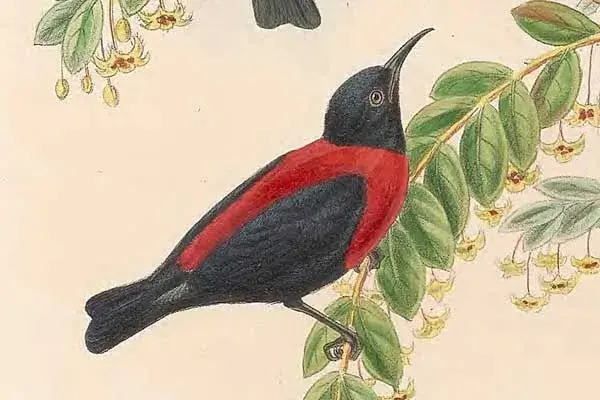
- Scientific name: Myzomela rosenbergii
- Lifespan: n/a
- Wingspan: n/a
Red-collared myzomelas are small honeyeaters native to New Guinea.
Often found in montane forests, they are hard to miss due to their appearance.
Males have stunning jet-black hoods, bellies, wings, tails, and bright red breasts, backs, rumps, and collars.
Females are smaller and mainly brown.
Red-collared myzomelas have a diet mainly consisting of nectar, some small arthropods, and small fruits.
These black birds with red rings around their necks are active, aggressive, and rather conspicuous.
They can be often seen in pairs or groups of up to 12 individuals, occasionally even more.
Red-collared myzomelas are also often noisy and can be identified by their high-pitched “tuweeist” or shorter “tswi” or “tsi” calls during flight.
Crimson-collared Tanager

- Scientific name: Ramphocelus sanguinolentus
- Lifespan: n/a
- Wingspan: n/a
Crimson-collared tanagers are small songbirds found in Mexico and Central America.
Their preferred habitats include edges of humid evergreen forests and verdant second growth.
These tiny black and red birds measure around 7.7 inches in length and weigh around 1.4 ounces.
Part of their scientific name “sanguinolentus” is a Latin word meaning “bloodied” and refers to their red color.
Male crimson-collared tanagers are black with red napes, necks, breasts, and tail coverts. Females resemble males but are slightly duller.
They are vocal birds whose song consists of 2-4 notes that sound like “tuee-teew, chu-chee-wee-chu“. They also have a “ssii-p” call that is emitted during flight or when perched.
They forage typically in pairs and consume fruit and arthropods.
Red Siskin

- Scientific name: Spinus cucullata
- Lifespan: 4 years in the wild
- Wingspan: n/a
Red siskins are small endangered finches native to South America.
Once common in the foothills of northern Venezuela, sightings of these birds are now extremely rare.
Male red siskins have red and black plumage while the females have a bit duller color and are mostly salmon-pink and gray.
Red siskins also have the deep, rich vermilion red color of their necks, breasts, bellies, and undertail coverts.
They are very social birds that have high-pitched chitters and sharp “chi–tit” calls.
Red siskins have a diet consisting of fruit, flower buds, grass seeds, and herbaceous plants.
They are listed as endangered by the IUCN and nationally critically endangered in Venezuela.
Crimson Finch

- Scientific name: Neochmia phaeton
- Lifespan: 5-6 years
- Wingspan: n/a
Crimson finches are small birds native to Northern Australia and southern New Guinea.
Nicknamed “blood finches” and “killer finches”, these small birds will attack birds of the same species as well as different species.
Due to such a reputation and a slightly higher price, people do not commonly keep them as pets.
Crimson finches have red beaks, faces, throats, breasts, and flanks. Their bellies and undertail parts are black. Upper tails coverts and rumps are crimson red while the backs, napes, and crowns are gray to almost black on their foreheads.
Crimson finches are monogamous and prefer habitats with tall, dense grasses, near riparian vegetation and rivers.
They are omnivores and feed on seeds and some insects.
Red-naped Ibis
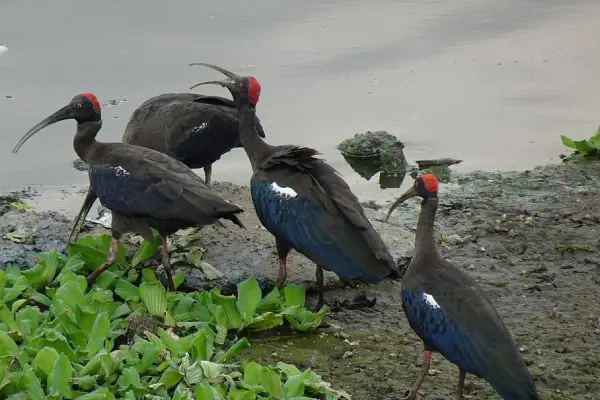
- Scientific name: Pseudibis papillosa
- Lifespan: up to 30 years
- Wingspan: 40 in
Red-naped ibises are large birds with long legs and downcurved beaks.
They are commonly found in the plains of southern Asia, mostly in India.
Red-naped ibises are all-black with crimson red patched on their crowns and napes. They also have white skin patches on their shoulders and black wings with blue-green gloss.
Although mostly quiet, these red and black birds will make various squealing and screaming calls.
They are also known as Indian black ibises and inhabit lakes, marshes, riverbeds, and irrigated farmlands.
Red-naped ibises can be commonly spotted alone or in loose groups.
They breed from March to October and use different sticks, straws, and fresh grasses to build their nests. Females will lay 2-4 pale bluish eggs and both parents will incubate them.
Red-naped ibises are omnivores and have a diet consisting of insects, frogs, grain, and even carrion.
Scarlet Tanager
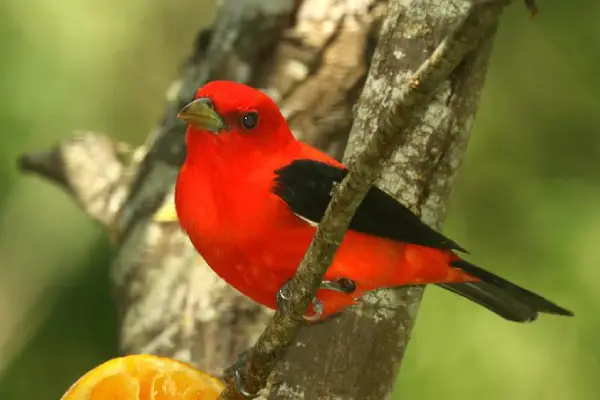
- Scientific name: Piranga olivacea
- Lifespan: up to 11 years
- Wingspan: 10-12 in
Scarlet tanagers are medium-sized songbirds with fairly large heads, thick, rounded beaks, and short and broad tails.
They breed in deciduous forests, especially with oaks, in eastern parts of North America.
First to arrive at their breeding grounds are males, followed by females a week later. After breeding, the pair will have a clutch of around 4 light blue eggs with a green tinge.
Scarlet tanagers are common in the US from April to October.
After that, they migrate to northwestern parts of South America.
These black and red birds almost became the state birds of Minnesota back in the 1950s but ultimately common loons were picked.
Male scarlet tanagers are bright red with black wings and tails; females are lime to yellow-green with white wing linings, and gray flank.
The song of male scarlet tanagers consists of a series of 4-5 chirruping phrases with a hurried quality. Females will sing more softly.
Source: G. McGrane, Public domain, via Wikimedia Commons
People often compare scarlet tanagers’ song to one of a robin with a sore throat. Their call is a distinctive “chip-burr.”
Scarlet tanagers forage high in trees and primarily feed on insects and some fruit.
Rose-breasted Grosbeak

- Scientific name: Pheucticus ludovicianus
- Lifespan: up to 24 years in captivity
- Wingspan: 11-13 in
Rose-breasted grosbeaks are large grosbeaks and medium-sized songbirds with large triangular beaks, stocky bodies, short necks, and squared tails.
They breed in open deciduous woods of Canada and the northeastern USA and migrate to their wintering grounds in Mexico, Central, and South America.
They can be seen in the USA from spring to fall, somewhere from April to September.
Male rose-breasted grosbeaks are black above, white below, and have rose-red upper breasts and underwings.
Females are brown and streaky.
Rose-breasted grosbeaks have a song that is a subdued mellow warbling, resembling a sweeter version of the song of the American robin. They also have a sharp “pik” call that resembles a woodpecker’s call.
Source: G. McGrane, Public domain, via Wikimedia Commons
They forage in shrubs and trees looking for insects, seeds, and berries.
Attract rose-breasted grosbeaks to your bird feeder by adding sunflower seeds, safflower seeds, and raw peanuts.
We also have a list of black birds with yellow wings, check it here.
Vermilion Flycatcher

- Scientific name: Pyrocephalus obscurus
- Lifespan: 4-5 years
- Wingspan: 9.5-10 in
Vermilion flycatchers are small songbirds found in southern North America and northern parts of South America.
They measure 5.1-5.5 inches long and weigh around 0.44 ounces.
They are sexually dimorphic species – males and females look different.
Male vermilion flycatchers have bright red crowns, chests, and underparts, and dark black-brown wings and tails.
Females are dark gray above and have orange bellies.
They have a “pip-pip-pip” song while their calls include sounds like “peee,” “peeent,” and “tjee-tjee“.
Despite being solitary most of the time, these black and red flycatchers will occasionally form small flocks of up to 5 birds during winter.
Vermilion flycatchers, as the name suggests, feed on insects, including flies, grasshoppers, and beetles, that they catch in flight.
They are monogamous and breed from March to June, but might copulate with other birds than their partners.
They have a clutch of 2-4 whitish eggs with brown spots that the female incubates while the male feeds her.
Sometimes, female vermillion flycatchers will lay their eggs in other vermilions’ nests for them to raise; brown-headed cowbirds will do the same (with vermilion flycatchers). This behavior is known as brood parasitism.
Northern Cardinal
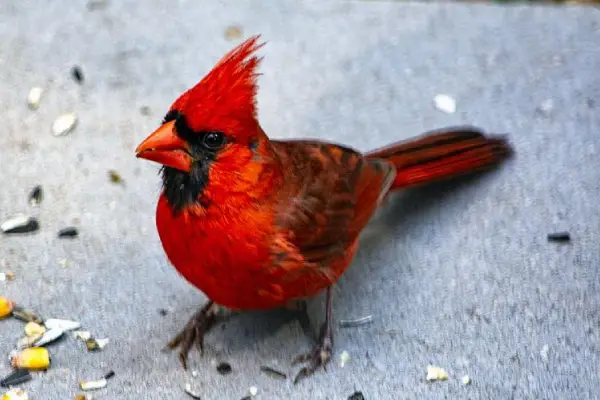
- Scientific name: Cardinalis cardinalis
- Lifespan: 3 years
- Wingspan: 10-12 in
Northern cardinals are medium-sized songbirds found in Southeastern Canada, Eastern USA, Mexico, and parts of Central America.
They inhabit woodlands, gardens, shrublands, and wetlands.
These beautiful birds with orange beaks and stunning head crests are sexually dimorphic.
Male northern cardinals are bright red with black throats and faces while the females are mostly brown with reddish wings and tails.
They are also known as redbirds and they get their red color from the food they eat – if there are not enough carotenoids in their food, they become brownish.
Listen for their 2-3 second song which is a loud string of clear down-slurred or two-parted whistles that sound like “cheer-cheer,” “birdie-birdie,” and “wheet-wheet.”
Northern cardinals’ most common call is a loud, metallic chip they use to chase away other males entering their territories.
Source: G. McGrane, Public domain, via Wikimedia Commons
These birds are very territorial and aggressive – northern cardinals will often try to ferociously attack their reflections in the mirrors and windows.
Attract northern cardinals to your bird feeder by adding some sunflower seeds, peanut hearts, millet, or milo.
They are omnivores that feed on seeds, fruit, and insects.
In case you notice male cardinals with baldness problems – it’s a sign they’re in the middle of a late summer molt.
These songbirds are also monogamous and mate for life.
We have a list of birds that are black and have red wings – check it here.
ʻIʻiwi

- Scientific name: Drepanis coccinea
- Lifespan: 5-12 years
- Wingspan: n/a
The ʻiʻiwi or scarlet honeycreeper is a species of honeycreeper native to the Hawaiian Islands.
Scarlet honeycreeper is easy to spot by the red feathers, black wings, black tail, and distinctive long curved salmon-orange beak.
Hawaiian mythology says that the demi-god Maui loved those forest birds so much that he painted them all bright red.
He made the ‘iʻiwi especially colorful and gave it a unique call that resonated throughout the forest; their song consists of a couple of whistles.
The ʻiʻiwi’s curved beak allows it to get nectar from flowers of the Hawaiian lobelioids, which have decurved corollas.
These red and black birds are listed as Vulnerable by the IUCN and have lost almost 90% of their range.
Read More: 18+ white-colored birds in Hawaii
Summary
This concludes our list of black and red birds.
Examples include several species of flycatchers, finches, tanagers, meadowlarks, frigatebirds, etc.
Next time, should you see these birds in person, you should be able to recognize any of them with ease!
And if you enjoyed our article, here are our other popular reads on birds: Examples of big red birds and Examples of black-colored waterbirds